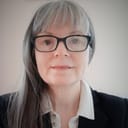Stay in the Loop
BSR publishes on a weekly schedule, with an email newsletter every Wednesday and Thursday morning. There’s no paywall, and subscribing is always free.
A pioneering artist, activist, and teacher
Woodmere Art Museum presents Barbara Bullock: Fearless Vision

Movement and musicality run through Barbara Bullock: Fearless Vision, a solo exhibition of more than 60 works in Woodmere Art Museum’s two-story main gallery. People jump, dance, and stretch; panthers prowl and slink; birds appear to fly over some of the works, peer down at others, or perch on wall texts. Throughout the show, the curators emphasize the interplay between Bullock’s work as a pioneering artist-activist and educator since 1966 and the trajectory of her studio practice. The Woodmere’s staff, together with Bullock and art historians Leslie King Hammond and Lowery Stokes Sims, have filled the museum’s Catherine M. Kuch Gallery with sculptures, assemblages, altars, drawings, paintings, collages, and lesson plans from the past 40 years.
A video conversation between Bullock, Hammond, and Sims plays in the gallery (also online), offering insights into Bullock’s artistic decisions. Inspired by her interests, research, and travels, many of her works are grouped within series, such as Initiation, Chasing After Spirits, and Straight Water Blues. The earliest works in the show, paintings and drawings from her Jasmine Gardens series from the 1980s, are displayed on the second-floor Dorothy J. del Bueno Balcony Gallery. These figurative nudes pull one another close in languorous, gestural poses. Another early series, Healer, was Bullock’s response to AIDS: magical paintings that incorporate complicated patterns and unexpected colors in the picture plane and within the figures themselves.
A creative leap
One morning in 1990, Bullock says in the video, she cut up a painting, moved the elements around, and reassembled them, which greatly animated the piece. Collage has been at the heart of her practice ever since. Her painted, cut, layered, and sculpted works—mostly in watercolor or acrylics on heavyweight paper—are sometimes looped into intricate three-dimensional shapes that look as if they were made of metal. Bullock achieves luminous depth in colors, and a personal visual vocabulary recurs throughout her works: animals, birds, snakes, patterns, cowries, lizards, and eyes add complexity and power to works like Child in the Land of the Spirits (1997).
An innovative teacher
Born and raised in North Philadelphia, with summer visits to family in North Carolina and Virginia, Bullock attended Fleisher Art Memorial (1956 to 1958) and Hussian School of Art (1963 to 1966), working as a private chef to pay for classes. During the 1960s, she began teaching in community centers in North Philadelphia and Germantown, forming friendships with artists Ellen Powell Tiberino, John Simpson, Moe Brooker, Charles Searles, and Arthur Hall, the dancer and choreographer who founded the Ile Ife Black Humanitarian Center in 1969. Bullock was director of the art department at Ile Ife from 1971 until 1975. Among many other teaching positions, she worked at Prints in Progress at Germantown Workshop for 13 years, serving as head artist there from 1988 through 1993.
Some of the innovative teaching tools Bullock created are displayed, including “magic” pinhole theaters, games, and pop-up books, allowing visitors to see glimpses of her dedication to nurturing creativity and community. The magic theaters, for instance, are created by the class, and each student displays an object meaningful to them, like a photograph or a button. After everyone has looked at it, the student tells the object’s story. By elevating the things that are important to them, Bullock demonstrates to the group—children, teachers, seniors, incarcerated people—the value of seeing and hearing one another.
A distinctly American Philadelphia artist
Her research into myths, stories, and traditions, particularly from African countries and the Caribbean, is woven into Bullock’s practice, and sketches and studies created during her travels add dimension to the retrospective. Yet Bullock’s work is distinctly American, and potent artworks in the exhibition refer to Jean-Michel Basquiat, Miles Davis’s Bitches Brew, Hurricane Katrina, and the murders of George Floyd and Trayvon Martin.

Several pieces are specific to Philadelphia. With El Dancers (2008), installed in SEPTA’s 46th Street Station on the Market-Frankford Line, Bullock nods to The Dance (1932-1933) by Henri Matisse at the Barnes Foundation. The church she attended as a child was recently demolished, but she associated its name, the Roman Catholic Church of Most Precious Blood, with her searing abstract work, Trayvon Martin, Most Precious Blood. In the video playing in the gallery, Bullock talks about the work: “I remember the mothers, and I [thought] God, that’s their most precious blood. … Mothers and sons were two hearts that didn’t look like hearts, entwined, and broken. I felt, we can say how we feel, but how do we really solve problems? Making art doesn’t seem like enough, but it’s what I do.”
This exhilarating retrospective reflects an artist concerned with the complexity of humanity, facing our tragedies while celebrating joy. Among programs that complement the exhibition are teacher workshops ($20) that offer credits toward required hours of continuing education under Pennsylvania Act 48. A gallery talk with Bullock, Hammond, and Sims takes place on Saturday, November 4, at 2pm ($10; free for members).
What, When, Where
Barbara Bullock: Fearless Vision. Through January 21, 2024, at Woodmere Art Museum, 9201 Germantown Avenue, Philadelphia. (215) 247-0476 or woodmereartmuseum.org.
Accessibility
All Woodmere galleries are wheelchair-accessible except the Dorothy del Bueno balcony, which is up one flight of stairs. Accessible parking is available near the Widener Studio building to the right of the museum, separate from the main parking area. Wheelchairs are available on request. For information and additional assistance, call (215) 247-0476 before visiting.
Sign up for our newsletter
All of the week's new articles, all in one place. Sign up for the free weekly BSR newsletters, and don't miss a conversation.
 Emily Schilling
Emily Schilling